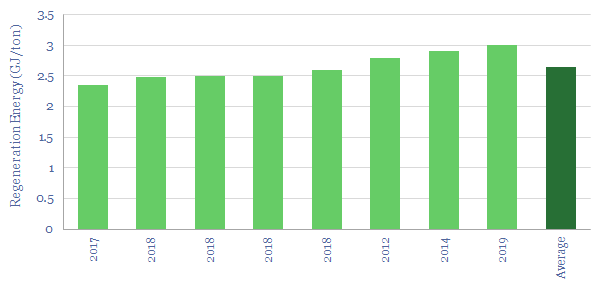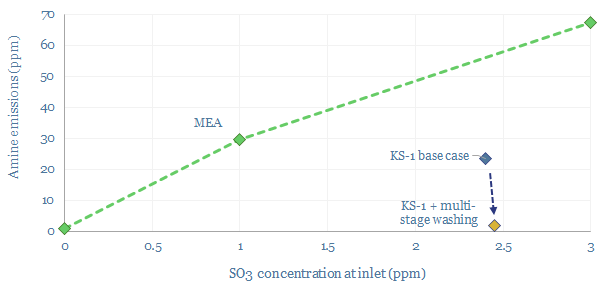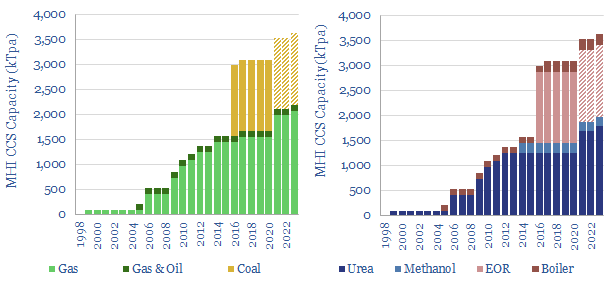MHI has deployed an amine-based CO2 capture technology, in 15 plants globally, going back to 1999. Reboiler duties are around 2.6 GJ/ton on a 10% CO2 feed. Capture rates and capture purity are high. Degradation and amine emissions are controlled, and c80-90% below MEA. CCS costs and complexities remain high. In our view, this is the true baseline for future next-generation amines to beat. This data-file aggregates notes and datapoints into MHI CCS technology.
KM-CDR is the Kansai Mitsubishi Carbon Dioxide Recovery Process, honed over three decades, by Mitsubishi Heavy Industries, from solvents through to entire CCS plants.
This data file aggregates useful reference data-points for decision-makers who care about parameters like CCS economics, energy penalties, amine degradation and technology risks.
Development timeline of MHI CCS technology? R&D into KM-CDR began in 1990, a 2Tpd pilot started in 1991 at Nanko power station, Japan; and the KM-CDR process was effectively developed by 1994, with the first commercial facility starting up in 1999. Details in the data-file.
MHI’s CCS technology has since been deployed in fifteen facilities globally, with almost 4MTpa of CCS capacity, of which over half are smaller facilities purifying CO2 for urea production, and the largest is the 1.4MTpa Petra Nova CCS project, which was the largest coal+CCS project in the world when it started up in 2016.
Is MHI’s CDR process ready for true CCS? The ‘success’ of Petra Nova remains somewhat controversial. The project started up on time and on budget, captured over 3.5MT of CO2 from 2017-19 and disclosed a CO2 capture rate of 92.4% when operating, piping away 99% pure CO2, for use in EOR at Hilcorp’s West Ranch Oil field. On the other hand, in its first three years of operation, “It suffered outages on 265 full days and 107 partial days, mostly in its first two years of operation” largely linked to CO2 pipeline availability, and was shut down for economic reasons in 2020. More details in the data-file.
The solvent for MHI’s CCS technology is KS-1, and more recently KS-21, a sterically hindered amine, supplemented by additives and promoters.
From reviewing technical papers, our best guess is that regeneration energy is 2.6 GJ/ton (40% below MEA), assuming a feed of 10% CO2 concentration, as is typical at a coal plant (more data here). Details on each study are in the data-file.

Degradation and amine emissions to the air of the MHI solvent are also discussed in the data-file, but in summary, we think they are 80-90% lower than MEA, especially when CO2 capture plants are fitted with all the usual bells and whistles to remove particulates, NOx and SO2 from exhaust gases upstream of the CO2 absorber unit, then the exhaust from the absorber is cleaned up with multi-stage washing (chart below).

Costs remain quite high in our view, and are likely well above the $50/ton in our economic model of a simple amine capture plant. This is mainly due to capex costs. Although MHI has been refining its CCS process, with smaller units, more modularity and improved solvents. Details are discussed in the Notes tab of the data-file.
What are the right baseline metrics for CCS solvents? Many CCS projects that have crossed our screen have seriously considered using MHI’s CCS process, and it is often the front-runner solution. This is because it is a fully engineered solution, with a track record, has been deployed at scale, has decent energy penalties and acceptably low degradation and emissions to air. Arguably, Shell’s CANSOLV is in a similar position.
Hence in our view, it is somewhat misleading when a new CCS technology advertises its performance ‘relative to MEA‘, which has notoriously high degradation rates and an regeneration energy requirement of 3.5-3.7 GJ/ton.
It is like claiming to have developed an automotive technology, which is a breakthrough when compared to the Ford Model T; or a portable electronics technology, which is a breakthrough when compared to the original 2007 Apple iPhone.
We would strongly advise developers of novel amines to publicly disclose their base case solvent regeneration energy (in GJ/ton of CO2), their base case degradation rates (in kg/ton of CO2, alongside exhaust gas purity parameters) and their expected amine emissions rates (in ppm of exhaust gas, with or without a water wash unit).
Further details on MHI’s CCS technology are explored in the data-file, a good baseline against which to compare other amine solvents and reactor designs. All of our CCS research is available here for TSE clients.
